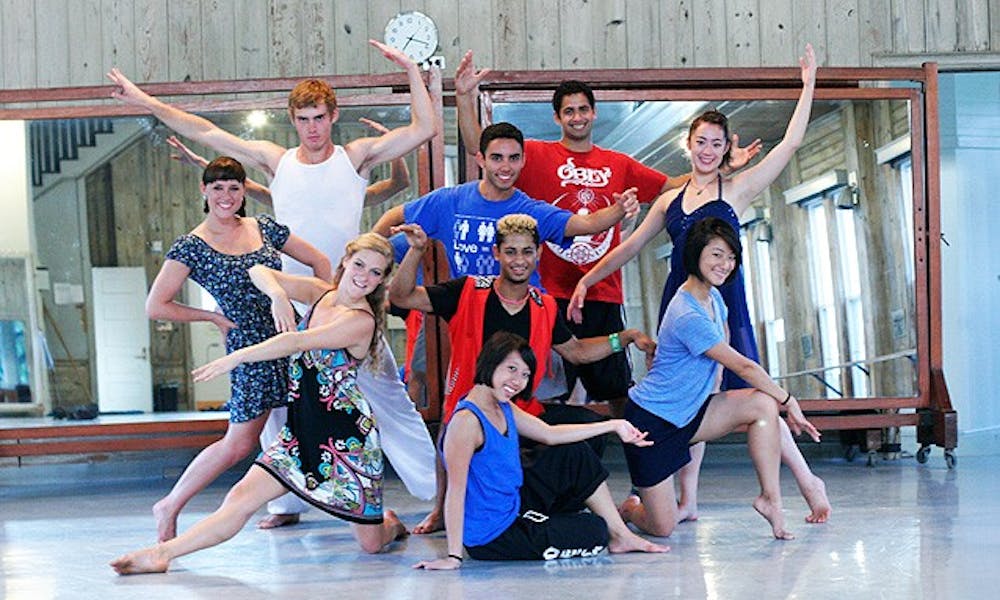Halfway around the world, the new Shenzhen Stadium rumbled with a bass-backed remix of The Sound of Music’s “Do-Re-Mi” as 300 dancers cantered onto a whorl-shaped stage. To a backdrop of camera flashes and rainbow LEDs, 12 Duke students filled the brightest spotlight, dancing front and center to 60,000 spectators.
The Duke University Dancers—as the group called themselves—highlighted the August 12 opening ceremony to the 2011 Summer Universiade Games in Shenzhen, China. The Universiade, often likened to the Olympic Games for collegiate athletes, marked the first performance in a month-long dance tour of China.
“This was really a once in a lifetime opportunity for all of us,” said team member and junior Ashley Tsai. “Waking up every morning and knowing that the only thing I had to do would be something that I love—this could only happen at Duke, with such a strong combination of academics and such great support for the arts.”
Representing a wide range of styles, from ballet to Latin to breakdancing, the team was selected from thousands of international applicants to perform. In addition to opening for the Universiade Games in Shenzhen, Hsiao-Mei Ku, a professor of the practice of music at Duke, arranged for the team to perform at seven other sites in China. These included Beijing, Hong Kong and the halftime of the first Duke men’s basketball exhibition game in Kunshan.
“I wanted to give them a bit more exposure to China, and China a bit more exposure to them,” said Ku, a native of China and member of Duke’s Ciompi quartet. “A lot of Chinese people follow American basketball, but not many people know that Duke has highly academically and artistically talented students.”
Luou Zhang, Trinity ’11, applied for the spot to perform after participating in DukeEngage’s arts education project in Zhuhai. After the organizers of the Universiade decreased funding for international performers, Ku and Scott Lindroth, Vice Provost for the Arts, stepped in. Lindroth, who arranged Duke’s financial support for the project, emphasized that success of the project was due to the students themselves.
“This initiative was entirely student-driven. The invitation was extended to the students, they organized it themselves,” Lindroth said. “There wasn’t a department or program sponsoring them like DukeEngage or study abroad.”
While overseas, the students took it upon themselves to immerse completely in Chinese culture—even in the midst of their tight rehearsal and performance schedule. The team had a rigorous learning curve: In addition to practicing routines at Duke during the spring semester, the team had two weeks to learn what their Chinese counterparts had been practicing for six. Practice sessions sometimes ran to 17 hours a day.
Despite the team members’ long work days and mutual widespread exhaustion, it was worth it to meet and share dance experiences with Chinese dancers throughout the nation. Incidentally, for many of the team members, cultural exchanges with Chinese dancers were the most salient memories of the project.
“Not only did the energy and dedication of the Chinese dancers wow us through those long days, but also their stories [impressed us],” Zhang said. “What their dreams are—some were professionals, some had never danced before. It was eye-opening.”
While only three members of the team spoke Mandarin Chinese, the team quickly found other ways to communicate—namely through its common bond, dance.
“Kartik [a team member] would go up to dudes and be like ‘b-boy? B-boy?’” recounted senior Will Beckman. “He didn’t speak any Chinese, so they’d all start making gestures and eventually form a circle and start dancing.”
Tsai recalled a similar experience with a young female dancer who observed the Duke dancers’ fusion of different dance styles.
“One girl commented that she really liked to watch us dance because we have a freedom of expression and each of us had an individual and unique style,” Tsai said. “She felt that that was somewhat missing in China.”
Through this communication, Ku sees the project as helping to address a critical need for the arts in modern China.
“What’s most interesting is how much the dancers benefited, and how much they taught [Chinese dancers] to stretch artistic boundaries,” Ku said. “When a society like China is developing so drastically and quickly, a lot of young people get lost—art is really the critical component in one’s education and life.”
Get The Chronicle straight to your inbox
Signup for our weekly newsletter. Cancel at any time.

